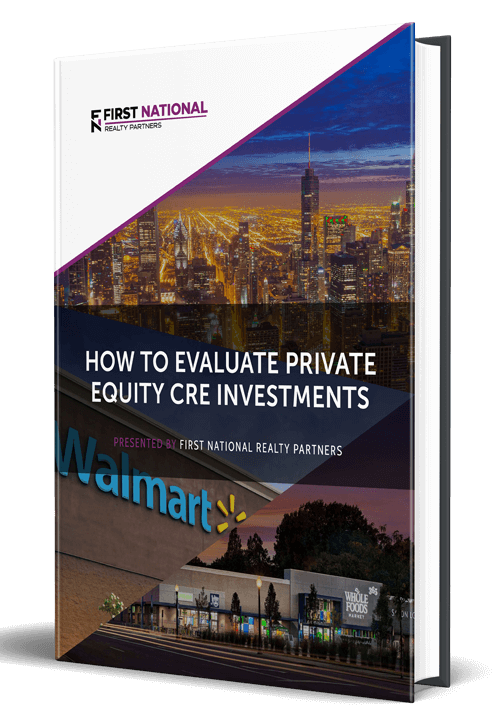Every real estate investor is unique. They each have their own levels of risk tolerance and their own investment return requirements. For this reason, there are a number of property types/investment strategies from which individuals can choose to ensure that the investment is a good fit for their unique preferences. One of those types, known as a “core plus” investment is the subject of this post.
In the article that follows, we will describe what a core plus property is, how they are identified, what returns can be expected, and how they compare to other common real estate investment strategies. By the end, readers will have the information needed to determine if a core plus investment is the right fit for their own investment portfolios.
At First National Realty Partners, we offer property types and investment strategies that can potentially meet the needs of a wide variety of investors. To learn more about our current opportunities, click here.
Core Plus Real Estate Defined
On a spectrum from safest/lowest return properties to highest risk/highest return, core plus properties sit somewhere between these two points. While the boundaries can be somewhat loosely defined, core plus properties generally exhibit the following characteristics:
- Age: 10 and 20 years old.
- Condition: Good condition, but may have some deferred maintenance that needs to be addressed.
- Market/Location: Good, not great locations. Core plus properties may not be in close proximity to major transportation arteries like train stops and airports. Or, they could be tricky to access from non-signalized intersections or roads without dedicated turn lanes.
- Tenants & Leases: Some high quality tenants on long term leases, but may have to deal with some expiring leases in the near term. Occupancy is mostly full with some vacancy.
- Leverage: Medium leverage, usually in the range of 50% to 65%.
- Finishes: Premium finishes, but may be somewhat dated.
Based on these characteristics, core plus properties have a slightly elevated risk profile when compared to core properties. This means that real estate investors expect a slightly higher return, usually in the range of 8% to 12%. Core plus investments tend to be a good fit for investors that have a small appetite for risk and a desire for some capital appreciation.
Examples of Core Plus Investments
Again, it is important to note that classification boundaries are somewhat arbitrary, but examples of core plus properties include a Class B multifamily apartment building, or an office building with somewhat dated finishes.
Pros and Cons of Core Plus Investments
There are pros and cons to core plus commercial real estate investments relative to the other options. The pros include:
- Consistency & Stability: Core plus properties have good tenants on medium to long term leases. As such, they are reliable income producers.
- Growth: Because they have a slightly elevated risk profile, core plus properties have the potential for some amount of price appreciation.
- Value: Because core plus properties may have some slight blemishes or may be slightly outdated, there is often good value to be found.
While these benefits are significant, they need to be weighed against the potential cons of a core plus real estate investment, which include:
- Age: Because of their age, core plus properties may have some wear and tear and/or deferred maintenance. This means that investors may need to invest some amount of capital replacing major systems or renovating interior finishes.
- Vacancies: Core plus properties may have some expiring leases in the short term. If one or more tenants decide not to renew their lease, a short term negative could turn into a long term issue if the space is not quickly re-leased.
- Volatility: Core plus cash flow can be somewhat unpredictable. As such, active management is required to minimize significant income variations.
For real estate investors who are comfortable with the risk/return profile of a core plus investment, there are two ways to invest, publicly or privately.
How To Invest In Core Plus Properties
The easiest and fastest way for investors to gain exposure to core plus properties is to purchase the publicly traded shares of REITs who invest in them. Because the boundaries between a core and core plus investment can be somewhat blurry, it can be tricky to differentiate between the investment strategies that pursue them. But, a multifamily REIT like Equity Residential could pursue a mix of core and core plus properties.
For investors who prefer private transactions, their best option is to either purchase the property themselves or partner with a private equity firm to purchase a fractional share of an institutional quality asset. In either case, it is up to the investor to identify the core plus strategy by evaluating the property themselves or by reading through the investment’s offering documents.
How Core Plus Investments Differ From Other Strategies
There are four widely recognized commercial real estate investment categories. In order of increasing risk/return, they are: core, core plus, value-add, and opportunistic. The following sections describe the differences between core plus and the other three.
Core Investments
As the name suggests, core investments are the foundation of any commercial real estate investment portfolio. Core properties are high quality/low risk assets that offer stable and consistent cash flows. A typical core investment is characterized by low leverage (40% – 50%), new or like new construction, high end finishes, and no major structural or operational issues. In addition, core investments typically have an excellent location with full or near full occupancy with credit tenants on long-term leases.
Examples of core properties include Class A multifamily assets, high rise office buildings, or a high end retail shopping center. Given their relatively low risk profile, core investors can typically expect annual returns in the range of 4% – 8%.
Value-Add Investment
The third step up from core investments are value-add properties (core plus properties are in the second position). A typical value-add property has a fair to good location, dated finishes, medium to high vacancy levels, and some amount of deferred maintenance that must be addressed. The goal of a value add investment strategy is to purchase the property for a good price and to invest some amount of money in renovations and physical improvements to bring the property up to core or core plus standards.
The additional risk in a value-add real estate investment comes from the execution risk of the renovation project and the increased leverage taken to finance it. As a result, expected returns for value-add investors tend to be in the range of 11% – 15% and consist of income and growth. Value-add investments tend to be a good fit for investors with a moderate risk tolerance and a desire for capital growth.
Opportunistic Investments
At the other end of the risk/return spectrum are opportunistic investments, which are the least predictable, but offer the highest potential upside. Opportunistic properties tend to have high levels of debt and vacancy and may need major repairs and/or a complete repositioning. Opportunistic properties also include ground up development because investors may have to go months or years without receiving any dividend income.
Given the high risk, an opportunistic strategy requires the highest return, typically 20%+. However, there can be a high degree of variability. For example, in a ground up development, investors may not see any return for multiple years while the property is under construction. Once construction is complete and units are leased or sold, the return ramps up and can be significant if the project is successful. Opportunistic investments tend to be a good fit for investors with the highest risk tolerance and/or longest time horizons.
Between these four categories, each investor should be able to find one or more opportunities that are a good fit for their own investment objectives and risk tolerance.
Core Plus Properties & Private Equity Real Estate
Private equity firms offer a variety of investment strategies, including those that seek to generate returns from core plus properties. As their name suggests, “private” equity investments fall into the private category described above.
For investors thinking about partnering with a private equity firm, it is important to complete due diligence on their approach, strategy, fees, and philosophy to understand exactly how they operate and to ensure it is a good fit for their own approach.
Summary of Core Plus Real Estate
On the risk/return spectrum, core plus real estate offers a low to moderate risk profile. Typical core plus properties are 10-20 years old, in good – not great – locations, and may have some deferred maintenance and expiring leases.
Examples of core plus investments include Class B multifamily properties or slightly dated office buildings in the central business district of tier 2 cities.
Individual or institutional investors can gain exposure to core plus properties through publicly traded investments like REITs or through partnership with a private equity firm.
Core plus investments are just one of four major commercial real estate classifications. The other three are core, value-add, and opportunistic.
Interested In Learning More?
First National Realty Partners is one of the country’s leading private equity commercial real estate investment firms. With an intentional focus on finding world-class, multi-tenanted assets well below intrinsic value, we seek to create superior long-term, risk-adjusted returns for our investors while creating strong economic assets for the communities we invest in.
If you are an Accredited Real Estate Investor and would like to learn more about our investment opportunities, contact us at (800) 605-4966 or info@fnrpusa.com for more information.






